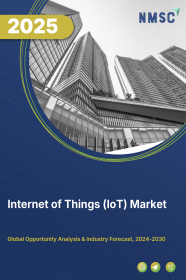
Internet of Things (IoT) Market by Component (Hardware, Software, and Services), by Deployment (On-Premise and Cloud), by Organization Size (Large Enterprises and Small & Mid-Size Enterprise), by Technology (Radiofrequency Identification, Pressure Sensors, Network Communications, Data Processing, and Near-field Communication), by Platform (Device Management, Application Management, and Network Management) and Others– Global Opportunity Analysis and Industry Forecast 2023-2030
Market Definition
The Internet of Things (IoT) Market size was valued at USD 541.72 billion in 2022 and is predicted to reach USD 2412.93 billion by 2030 with a CAGR of 23.8% from 2023-2030.
The Internet of Things (IoT) can be described as a network of physical objects that are embedded with sensors, software’s and other technologies for connecting and exchanging data with other electronic devices and systems over the internet. IoT devices can range from ordinary household objects such as kitchen appliances, thermostats or baby monitors to sophisticated industrial equipment’s such as vision guided inspection robots and autonomous warehouse robots.
IoT system works through the collection and exchange of real-time data and it has three major components such as smart devices, IoT application and a graphical user interface. Smart devices collect data from its environment, user inputs, or usage patterns, which is integrated by IoT applications using machine learning or artificial intelligence (AI) technology to analyze and provide required information. This is managed by a user through a graphical user interface in a mobile device or website.
Market Dynamics and Trends
Increasing availability of affordable smart home products such as smart speakers, smart lights, and security cameras by leading global brands including Google, Amazon and Apple is rapidly increasing the adoption of these IoT devices is in turn driving the growth of the market. For instance, in March 2021, Google launched the second-generation Google Nest Hub smart display for 99 USD. It is used to control other connected devices in a smart home and includes a built-in Soli chip for music controls and sleep tracking.
Also, integration of IoT-based solutions for predictive maintenance in the logistics industry to collect and store analytical data is further driving the growth of the market. Such data is used to run machine learning algorithms on multiple computers parallelly to forecast potential hazards and pinpoint industrial equipment’s that are probable to fail. For instance, in November 2020, Material Handling Systems, Inc. introduced IoT-based predictive maintenance solution for logistics facilities called MHS Insight. It is a condition-based maintenance solution that monitors assets through IoT sensors and system data to provide timely maintenance recommendations and health assessments of industrial equipment.
However, factors such as cyber security and privacy issues associated with IoT devices are restraining the growth of IoT market. On the contrary, introduction of industry 4.0 that integrates IoT with industrial robots and high-speed internet for better connectivity and automation is expected to create ample opportunities for the market in the coming years.
Market Segmentations and Scope of the Study
The Internet of Things (IoT) market share is segmented on the basis component, deployment, organization size, technology, platform, end user industry, and region. Based on component, the market is divided into hardware, software, and services. The services segment is further classified into professional services and managed services. The professional services market is further divided into consulting, implementation and support & maintenance. Based on deployment, the market is classified into on-premise and cloud.
On the basis of organization size, the market is categorized into large enterprises and small and mid-size enterprise (SMEs). Based on technology, the market is divided into radiofrequency identification, pressure sensors, network communications, data processing and near-field communication. On the basis of platform, the market is divided into device management, application management, and network management. Based on end user industry, the market is classified into manufacturing, automotive & transportation, healthcare, retail, energy & utilities, residential, agriculture, IT & telecom, and others. Regional breakdown and analysis of each of the aforesaid segments includes regions comprising North America, Europe, Asia-Pacific, and Rest of World (RoW).
Geographical Analysis
North America holds the dominant share of IoT market, and is expected to continue its dominance during the forecast period. This is attributed to factors such as well-established healthcare system in this region that enables public healthcare providers to adopt advance healthcare technology such as IoT analytics that uses IoT devices to track patients’ health remotely. For instance, in August 2021, Tabula Rasa HealthCare introduced a remote patient monitoring service in U.S. that employs biosensors and artificial intelligence to track patients' vital signs and notify medical personnel as needed.
Moreover, the presence of key market players such as Amazon, Intel Corporation, IBM, and Oracle Corporation further boost the market growth in this region. For instance, in June 2020, Amazon Web Services (AWS), subsidiary of Amazon.Com Inc., announced the launch of AWS IoT Greengrass 2.0. AWS IoT Greengrass is an open-source edge runtime and cloud service for building, deploying, and managing device software. It is now available as an open source under Apache 2.0 license.
On the other hand, Asia-Pacific is expected to show a steady rise in the IoT market due to the presence of high population in countries such as China and India that leads to the adoption of consumer IoT devices such as smartwatches and fitness bands.
Moreover, increasing sales of electric vehicles in countries such as China, Japan and South Korea that integrates IoT devices in battery management system (BMS), predictive maintenance system and for connected car technology is further driving the growth of the market. According to the China association of automobile manufacturers, the total number of EVs sold in China was 3.5 million in 2021.
Competitive Landscape
Various market players operating in the Internet of things (IoT) market includes Amazon.Com Inc., Intel Corporation, Microsoft Corporation, PTC Inc., Robert Bosch GmbH, Cisco Systems Inc., IBM Corporation, Oracle Corporation, SAP SE, and Siemens AG among others.
These market players are completing acquisition and launching numerous products across various regions to maintain their dominance in the Internet of things (IoT) market. For instance, in June, 2022, Oracle acquired Cerner corporation for 28.4 billion USD. Through this acquisition, Oracle aims to develop a national health records database that will be connected to electronic health records (EHRs) at hospitals. EHR’s will be connected to IoT devices for remote patient monitoring.
Moreover, in June 2021, Amazon announced the general availability of Amazon Web Services (AWS) IoT ExpressLink. AWS IoT ExpressLink is connectivity software that makes it easier and faster to connect any IoT device to the cloud, including medical devices, industrial sensors and consumer products.
Key Benefits
-
The internet of things (IoT) market report provides the quantitative analysis of the current market and estimations from 2023 to 2030. This analysis assists in identifying the prevailing market opportunities to capitalize on.
-
The study comprises of a detailed analysis of the internet of things (IoT) market trends including the current and future trends for depicting the prevalent investment pockets in the market.
-
The information related to key drivers, restraints, and opportunities and their impact on the internet of things (IoT) market is provided in the report.
-
The competitive analysis of the market players along with their market share in the internet of things (IoT) market is mentioned.
-
The SWOT analysis and Porter’s Five Forces model are elaborated in the study.
-
The value chain analysis in the market study provides a clear picture of the stakeholders’ roles.
Key Market Segments
By Component
-
Hardware
-
Software
-
Services
-
Professional Services
-
Consulting
-
Implementation
-
Support & Maintenance
-
-
Managed Services
-
By Deployment
-
On-Premise
-
Cloud
By Organization Size
-
Large Enterprises
-
Small And Mid-Size Enterprise (SMEs)
By Technology
-
Radiofrequency Identification
-
Pressure Sensors
-
Network Communications
-
Data Processing
-
Near-field Communication
By Platform
-
Device Management
-
Application Management
-
Network Management
By End User Industry
-
Manufacturing
-
Automotive & Transportation
-
Healthcare
-
Retail
-
Energy & Utilities
-
Residential
-
Agriculture
-
IT & Telecom
-
Others
By Region
-
North America
-
The U.S
-
Canada
-
Mexico
-
-
Europe
-
The UK
-
Germany
-
France
-
Italy
-
Spain
-
Denmark
-
Netherlands
-
Finland
-
Sweden
-
Norway
-
Russia
-
Rest of Europe
-
-
Asia-Pacific
-
China
-
Japan
-
India
-
South Korea
-
Australia
-
Indonesia
-
Singapore
-
Taiwan
-
Thailand
-
Rest of Asia-Pacific
-
-
RoW
-
Latin America
-
Middle East
-
Africa
-
Key Players
-
Amazon.Com Inc.
-
Intel Corporation
-
Microsoft Corporation
-
PTC Inc.
-
Robert Bosch GmbH
-
Cisco Systems Inc.
-
IBM Corporation
-
Oracle Corporation
-
SAP SE
-
Siemens AG
REPORT SCOPE AND SEGMENTATION:
|
Parameters |
Details |
|
Market Size in 2022 |
USD 541.72 Billion |
|
Revenue Forecast in 2030 |
USD 2412.93 Billion |
|
Growth Rate |
CAGR of 23.8% from 2023 to 2030 |
|
Analysis Period |
2022–2030 |
|
Base Year Considered |
2022 |
|
Forecast Period |
2023–2030 |
|
Market Size Estimation |
Billion (USD) |
|
Growth Factors |
Increasing availability of affordable smart home products such as smart speakers, smart lights, and security cameras. Integration of IoT-based solutions for predictive maintenance in multiple industries. |
|
Countries Covered |
28 |
|
Companies Profiled |
10 |
|
Market Share |
Available for 10 companies |
|
Customization Scope |
Free customization (equivalent up to 80 working hours of analysts) after purchase. Addition or alteration to country, regional, and segment scope. |
|
Pricing and Purchase Options |
Avail customized purchase options to meet your exact research needs. |




















 Speak to Our Analyst
Speak to Our Analyst
























